
Hobbycraft 1/48 CF-105 Arrow
| KIT #: | HC 1651 |
| PRICE: | $35 when new |
| DECALS: | Five options |
| REVIEWER: | Spiros Pendedekas |
| NOTES: |

| HISTORY |
The origins of the Arrow can be traced back In the post-Second World War
period, when Canada, like many other western countries, seeked their long
range interceptor to counteract the Soviet long range nuclear bomber threat.
Upon realizing that the delays in developing of the CF-100 Canuck (which was
Avro Canada’s first attempt to fulfill the above requirement) might
consequently affect its envisaged supersonic successor, the RCAF wasted no
time and submitted a requirements report to Avro Canada as early as March
1952, half a year earlier than the Canuck entered service, calling for an
advanced, all-weather, supersonic, missile armed long range interceptor.
The aggressive
requirements and tight time frame brought intensive discussions between Avro
and the RCAF, finally resulting in Specification AIR 7-3 which called for a
twin-engine, two-crew supersonic aircraft with a range of 300 and 200 nm for
low and high speed missions respectively, attaining a Mach 1.5 cruising
speed at 70,000 ft and sustaining 2g turns with no loss of speed or altitude
at Mach 1.5 and 50,000 ft. The specification additionally required five
minutes from starting the aircraft's engines to reaching 50,000 ft and Mach
1.5 and also less than 10 minutes turn-around time on the ground, while
being capable of operating from a 6,000 ft runway
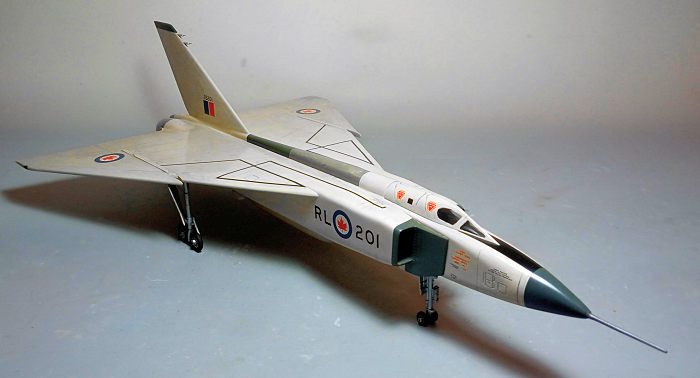 To meet
the strict time frame set by the RCAF, Avro took a high-risk approach by
skipping the traditional hand-built prototype phase and building the plane
directly from the production line. This risk was further augmented by the
fact that leading edge (and, to a degree, unproven) technology would vastly
be utilized at all basic aspects of the design.
To meet
the strict time frame set by the RCAF, Avro took a high-risk approach by
skipping the traditional hand-built prototype phase and building the plane
directly from the production line. This risk was further augmented by the
fact that leading edge (and, to a degree, unproven) technology would vastly
be utilized at all basic aspects of the design.
The big plane would feature a shoulder mounted delta wing, with a basic
fly-by-wire system employed to assist the pilot tackling the charismatic but
idiosyncratic delta wing. Power would be supplied by two Orenda Iroquois
engines, which were then in development stage.
RL-201, the first
Arrow (Mk.1), was rolled out to the public on 4 October 1957, which was the
same day Sputnik I was launched. The plane started flight tests on 25 March
1958 and the fact that the radical design quickly demonstrated excellent
handling and overall performance, reaching, among others, Mach 1.9 in level
flight with surprisingly few and not difficult to tackle bugs, can be
credited to Avro engineers.
Another four Mk.1s were completed, RL-202, RL-203, RL-204 and RL-205. When
the lighter and more powerful Orenda Iroquois engine became available,
RL-206, the first Iroquois powered Arrow (Mk.2), was by early 1959 ready
for taxi tests in preparation for flight and acceptance tests by RCAF
pilots.
All the same, on
20 February 1959, Prime Minister of Canada John Diefenbaker halted the
development of both the Arrow and its Iroquois engines, even before the
scheduled project review to evaluate the program could be held. Two months
later the assembly line, tooling, plans, existing airframes and engines were
ordered to be destroyed. This cancellation effectively put Avro out of
business, with its highly skilled engineering and production personnel
scattered.
The cancellation of the Arrow not only raised considerable political
controversy at the time, but also still remains a topic for debate among
historians and industry pundits. On the one hand, the plane was supremely
designed for its intended purpose and the preproduction machines performed
miraculously for such an advanced design. By all means, the Arrow would have
been a magnificent aircraft if produced. On the one hand, the project was
too costly (though a number of historians state that cost estimations were
unrealistically inflated), too aggressive and highly specialized, so when
the threat that the Arrow was supposed to counteract changed (from invading
nuclear bombers to ICBMs) the big, expensive plane had a hard time
justifying its cost effectivity, if not its necessity in general.
As for the
conspiracy theories surrounding the immediate destruction of all planes,
tools and plans, a more modest approach might lead to a plausible conclusion
that it was a move to ensure that the leading edge technology embodied in
the Arrow program would not fall into enemy hands. Legend has it that an
intact Arrow has been flown and stored “somewhere”.
| THE KIT |
Hobbycraft surprised the modeling world when it came with a 1/48 Avro Arrow
as “early” as in 1987. Though a “modern” tooling and reasonably accurate in
external details, the kit suffered from oversimplifications at key areas,
such as the cockpit, landing gear, intakes and exhausts. Hobbycraft retooled
the kit in 2003, addressing to a degree a number of the above discrepancies.
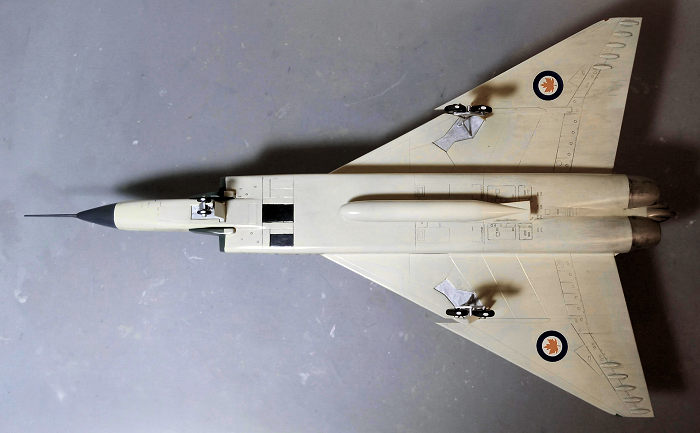 The
specific kit is the initial 1987 release. It was discovered at around 2005
in a small toy shop in Thessaloniki Greek city, together with the company’s
1/48 Avro CF-100 Canuck, offered at really low prices (presumably the shop
owner did not know that, even by then, those models had become collectors’
items. Needless to say I bought them both (and skipped buying the other 1/48
Canuck and 1/72 Arrow that the shop had, a lifetime regret…).
The
specific kit is the initial 1987 release. It was discovered at around 2005
in a small toy shop in Thessaloniki Greek city, together with the company’s
1/48 Avro CF-100 Canuck, offered at really low prices (presumably the shop
owner did not know that, even by then, those models had become collectors’
items. Needless to say I bought them both (and skipped buying the other 1/48
Canuck and 1/72 Arrow that the shop had, a lifetime regret…).
This Arrow kit
came in a big and quite sturdy top opening box, depicting RL-201, the first
prototype, dramatically flying in stormy skies. Upon opening the box, to my
surprise, I was greeted with a mere 50 white styrene parts, arranged in 4
separately bagged sprues, with the two big fuselage halves bagged together.
Molding is crisp, while panel lines are recessed and tad more pronounced
than they should be..
Cockpit is sparse, including only two crude seats, a stick and two pilot
figures. While the rear crew area will hardly be visible through the small
window, the front one’s sparsity will be evident even through the closed
canopy, so, unless you use the pilot figures, you must somehow beef up the
area. The other main key area of the landing gear is also simplistically
done, with the parts looking plain (towards toy-ish detail wise and the bays
featuring insufficient depth, something also true for the shallow intakes
and simplified exhausts. Ordnance includes an external tank and 8 average
looking missiles.
The one piece canopy is well molded and clear. Instructions are sufficient,
coming in the form of a b/w pamphlet, where the simple construction is
spread in 9 clear and concise steps, with color callouts given at some, but
not all areas. One basic white scheme is provided in three variations, in
full white and in two styles of day-glo orange applied on the fin, wingtips
and nose, so all five prototypes can be built. The decal sheet is well
printed, but wording on some stencilling was incomprehensible.
Instructions want
you to first assemble the simplistic cockpit and trap it between the nose
halves, together with 30 to 50 grams of weight in the front, to avoid tail
sitting. The nose gear is then to be assembled and attached (I would prefer
attaching it on final stages), followed by the 2-piece main fuselage. The
wings are then assembled and glued on, followed by the 2-piece intakes, the
top spine, the 2-piece fin, the aft engine cover panel and the exhausts. The
landing gear can then be assembled and attached, followed by the drop tank,
the missiles and the canopy, ending a very simple, straightforward build
(which can be explained by the equal simplicity of the model).
| CONSTRUCTION |
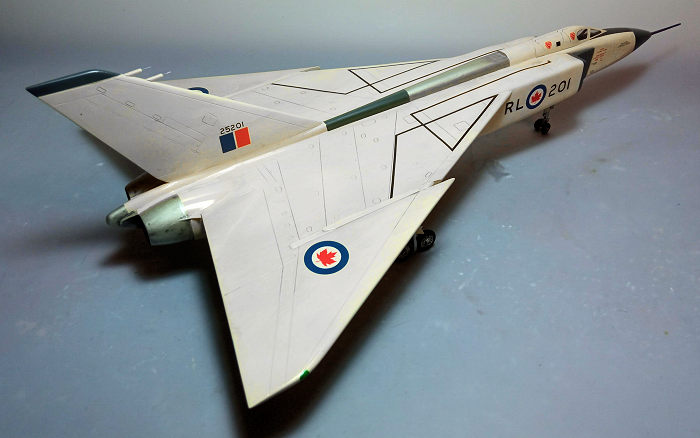 I
started by attaching the two seats and the pilot’s stick on the cockpit
floor and trapped it between the nose halves. Some 50 grams of fishing
weights were secured in the front, to avoid tail sitting. Basic cockpit
color, including the stick body and seat framing was a medium gray, while
the seats had red head cushions, green lower cushions and received seat
belts made from masking tape. An acetate piece represented a simplistic HUD.
I
started by attaching the two seats and the pilot’s stick on the cockpit
floor and trapped it between the nose halves. Some 50 grams of fishing
weights were secured in the front, to avoid tail sitting. Basic cockpit
color, including the stick body and seat framing was a medium gray, while
the seats had red head cushions, green lower cushions and received seat
belts made from masking tape. An acetate piece represented a simplistic HUD.
The two very long
fuselage halves were then joined and attached to the front part, followed by
the 2-piece intakes, the 2-piece wigs, the dorsal spine with the 2-piece fin
on top of it, the rear top engine cover panel and the dual exhaust piece.
The drop tank was assembled at this time, as well.
As surprising as
it might sound, this concluded basic assembly, which was reminiscent of a
simple 1/72 kit. Fit, while not bad, required small amounts of filler at
quite a few joints. After some rounds of filling and sanding, I mounted and
masked the canopy and took the big bird to the paint shop!
| COLORS & MARKINGS |
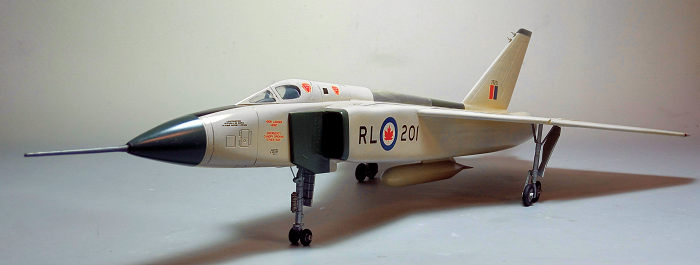 Deciding to
go for the initial RL201 prototype, I gave the complete model a coat of Hu22
Gloss White, including the gear doors and drop tank. The front anti glare area
and a couple of panels underneath were painted black, the spine’s front part
was painted “steel”, while the nose cone, the intakes area, the fin top fairing
and the spine’s aft section were painted Hu123 Extra Dark Sea Gray. The nozzles’
external and the adjacent central heat resistant area were painted Testors
Burned Metal, while the nozzles’ shallow innards were painted black, to add a
sense of depth.
Deciding to
go for the initial RL201 prototype, I gave the complete model a coat of Hu22
Gloss White, including the gear doors and drop tank. The front anti glare area
and a couple of panels underneath were painted black, the spine’s front part
was painted “steel”, while the nose cone, the intakes area, the fin top fairing
and the spine’s aft section were painted Hu123 Extra Dark Sea Gray. The nozzles’
external and the adjacent central heat resistant area were painted Testors
Burned Metal, while the nozzles’ shallow innards were painted black, to add a
sense of depth.
Onto
decaling, where I used the kit decals to represent RL-201, which was the first
prototype. Decals, including the complex shaped wing walk lines, behaved nicely,
easily detaching from their backing sheet and nicely adhering to the gloss white
surface. Apart from some mislettering in a couple of stencils, everything else
was good with the decals, with a coat of Future sealing them.
| FINAL CONSTRUCTION |
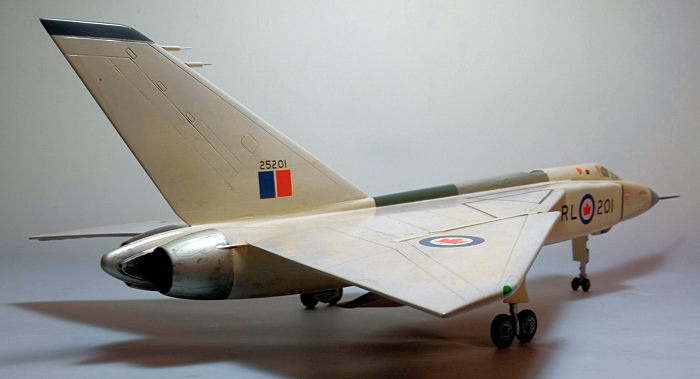 The long
landing gear was assembled and attached in position, with the bird securely
standing on its feet. As mentioned above, the landing gear is extremely
simplified, with the wheel wells being totally flat and featuring no depth. To
partially hide this flatness, I attached the main doors “closed”, while in pics
they are shown “open”. for the rest, I left everything “as is”. All landing gear
parts, including bays and door innards were painted Tamiya X-11 Silver and tires
were painted black. The wheels were tad filed to look weighted. The drop tank
was attached at this time, as well.
The long
landing gear was assembled and attached in position, with the bird securely
standing on its feet. As mentioned above, the landing gear is extremely
simplified, with the wheel wells being totally flat and featuring no depth. To
partially hide this flatness, I attached the main doors “closed”, while in pics
they are shown “open”. for the rest, I left everything “as is”. All landing gear
parts, including bays and door innards were painted Tamiya X-11 Silver and tires
were painted black. The wheels were tad filed to look weighted. The drop tank
was attached at this time, as well.
Since this bird was
kept in pristine condition, apart from a black wash to accentuate the nice
engraved details, no other weathering was applied, with a final satin coat
giving the bird its final hue.
The
canopy had its well defined frames hand painted and attached in position, with
fit being sufficient. The long pitot was painted gunmetal and attached. The two
fin-located probe tips were replaced with pieces of stretched sprue to look more
scale. Finally, blobs of red and green clear paint represented the wingtip
lights, before calling the Arrow done!
| CONCLUSIONS |
If
you want a 1/48 Avro Arrow, this is it, with its 1/72 version being the only
other choice (together with an even more obscure 1983 Astra resin offering). The
kit has only been reissued two times, in 1999 and in 2003, the latter featuring
improved molds with better details. Not sure if Academy (which seems to have
gotten hold of Hobbycraft’s molds) will ever reissue it, this kit is a pure
collector’s item as of 2024, so, if you are lucky to find one, you will have to
pay a quite a hefty amount of money.
Hobbycraft's 1/48
Arrow is a very interesting case (with the same applying to its very similarly
engineered 1/72 version). On the one hand, the kit is simplified especially at
the key areas of cockpit, landing gear, intakes and exhausts. On the other hand,
it looks accurate, molding is crisp and features engraved panel lines, parts
count is surprisingly low (explained by the aforementioned simplified
engineering and lack of detail) with construction being a breeze.
True,
Hobbycraft has to be credited for coming up with a “modern” mold of an iconic
yet esoteric subject in 1/48 (and in 1/72, as well) as “early” as in 1987, but,
conversely, it would’n hurt to offer more detail at key areas. That said, the
model can either be built effortlessly out of the box, or beefed up with extra
work and/or some aftermarket stuff. Either case, the final result will be quite
imposing and “different”, just make sure that you have some free shelf space, as
the completed model is quite sizable.
Happy Modeling!
20 January 2025
Back to the Previews Index Page
Back to the Previews Index Page